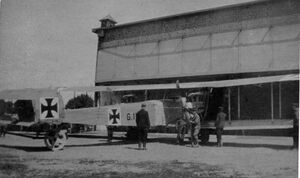Engineering:Friedrichshafen G.I
| G.I | |
|---|---|

| |
| Role | Bomber |
| Manufacturer | Flugzeugbau Friedrichshafen GmbH |
| Designer | Karl Gehlen |
| First flight | 1915 |
| Primary user | Luftstreitkräfte |
| Number built | 1 |
The Friedrichshafen G.I (factory designation FF.36 or FF.30[citation needed]) was a prototype heavy bomber aircraft that was built in Germany by Flugzeugbau Friedrichshafen in 1915. It was Karl Gehlen's first design for the company, and although it was not produced in quantity, it provided the foundation for the later, highly successful bombers culminating in the G.III.
Design and development
The Friedrichshafen G.I first flew in 1915 and was originally conceived as a battle-plane but the design emphasis was shifted to the bomber role when the battle-plane concept proved unworkable. The G.I was a biplane with a crew of three and armament of a single machine gun mounted on a gun ring in the nose of the aircraft. The front part of the fuselage was covered with plywood while the rear half of the fuselage was fabric covered as were the wings and the tail surfaces. The biplane wings were braced by three pairs of interplane struts on each side of the fuselage while the tail unit was a box-shaped biplane unit with two rudders mounted between the tips of the horizontal stabilizers. The fuselage was attached to the lower wing and the two engine nacelles were suspended between the wings by a system of struts. Each nacelle housed a six-cylinder 110 kW (150 hp) Benz Bz.III engine in a pusher configuration.
Operators
 German Empire
German Empire
- Luftstreitkrafte
Specifications (G.I)
Data from [1]
General characteristics
- Crew: 3
- Length: 11.9 m (39 ft 1 in)
- Wingspan: 21.2 m (69 ft 7 in)
- Height: 3.15 m (10 ft 4 in)
- Wing area: 73.5 m2 (791 sq ft)
- Empty weight: 1,778 kg (3,920 lb)
- Gross weight: 2,785 kg (6,140 lb)
- Powerplant: 2 × Benz Bz.III 6-cylinder water-cooled in-line piston engine, 110 kW (150 hp) each
- Propellers: 2-bladed pusher propellers
Performance
- Maximum speed: 136 km/h (85 mph, 73 kn)
- Range: 610 km (380 mi, 330 nmi)
Armament
- Guns: 2 × 7.92 mm (0.312 in) Parabellum MG14 machine guns
- Bombs: 200 kg (440 lb) of bombs
See also
- Idflieg aircraft designation system
Aircraft of comparable role, configuration and era
- AEG G.I
- AEG G.II
- Gotha G.I
References
- ↑ Kober, Theodor von; Borzutzki, Siegfried (in German). Flugzeugbau Friedrichshafen GmbH : Diplom-Ingenieur Theodor Kober (1. Aufl ed.). Burbach. p. 121. ISBN 978-3927513600.
Bibliography
- Herris, Jack (2016). Friedrichshafen Aircraft of WWI: A Centennial Perspective on Great War Airplanes. Great War Aviation Centennial Series. 21. Charleston, South Carolina: Aeronaut Books. ISBN 978-1-935881-35-3.
Further reading
- Taylor, Michael J. H. (1989). Jane's Encyclopedia of Aviation. London: Studio Editions. pp. 413.
- World Aircraft Information Files. London: Bright Star Publishing. pp. File 894 Sheet 47.
 |

